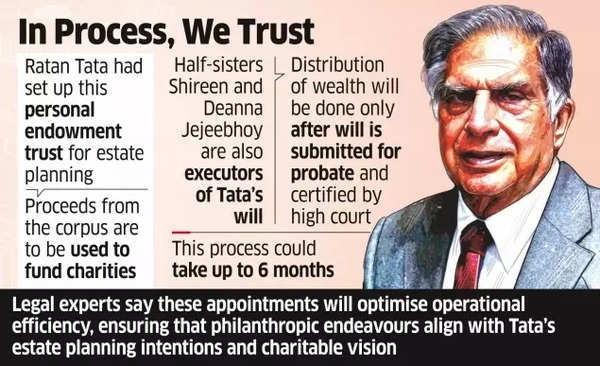
Noel Tata, Ratan Tata’s half sisters Shireen and Deanna Jejeebhoy join board of Ratan Tata Endowment Trust – The Times of India
Noel Tata, who chairs Tata Trusts, has joined the Ratan Tata Endowment Trust (RTET) board alongside Shireen and Deanna Jejeebhoy, who are half-sisters of late Ratan Tata. The existing trustees, Pramit Jhaveri and Darius Khambata, made these appointments, according to sources.
The Trust has also welcomed two Tata group executives, RR Shastri and Jamsheed Poncha, as new appointees. Following these additions, Khambata has resigned from the RTET board, according to an ET report.
Sources told the financial daily that RTET has the potential to work jointly with Tata Trusts on scalable projects of mutual interest.
Both Deanna and Shireen Jejeebhoy serve as executors of Ratan Tata’s will. Legal experts confirm that there are no restrictions preventing will beneficiaries or executors from holding positions in organisations mentioned within the will. They note that personal laws are private and typically cannot impose restrictive elements in a will.

In process, we trust
The distribution of Ratan Tata’s assets will commence after the will undergoes probate and receives high court certification, a procedure that typically requires up to six months.
Ratan Tata established this personal endowment trust alongside the Ratan Tata Endowment Foundation for estate planning purposes, with the trust’s corpus earnings allocated to support future charitable initiatives.
Shrenik Gandhi, Managing Partner at Chambers of Shrenik Gandhi, explains that Rata Tata Endowment Foundation (RTEF) operates as a Section 8 company under the Companies Act, 2013, focusing primarily on philanthropic activities. Meanwhile, RTET, being a private trust, falls under the jurisdiction of the Indian Trusts Act, 1882.
Also Read | Ratan Tata will: Who is Mohini Mohan Dutta? Meet former Tata group employee who may receive one-third of Tata’s residual estate
According to legal specialists, an endowment fund serves as a financial instrument that aims to maintain and expand capital through careful investment approaches to create sustained income for charitable work. A trust, however, functions as the legal structure that maintains, operates and supervises assets, ensuring their utilisation aligns with specified charitable goals and stipulations.
“This is significant in strengthening the governance framework and operational oversight,” said Nilesh Tribhuvann, Managing Partner, White & Brief – Advocates & Solicitors. “Such appointments can provide enhanced fiduciary responsibility, reinforce accountability, and foster agile decision-making processes. This move is strategically poised to optimize operational efficiency, ensuring that philanthropic endeavours align seamlessly with Ratan Tata’s estate planning intentions and charitable vision,” adds Tribhuvann.